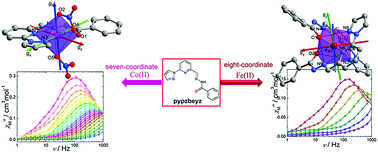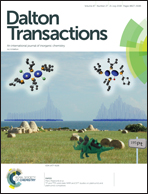High-coordinate CoII and FeII compounds constructed from an asymmetric tetradentate ligand show slow magnetic relaxation behavior†
Abstract
Using an asymmetric tetradentate ligand N-((6-(1H-pyrazol-1-yl)pyridin-2-yl)methylene)benzohydrazide (pypzbeyz), two high-coordinate 3d transition metal compounds [CoII(pypzbeyz)(NO3)2] (1) and [FeII(pypzbeyz)2](BF4)2(CH3CN) (2) have been synthesized and characterized by structural and magnetic measurements. X-ray crystallographic analyses revealed that compound 1 is seven-coordinate with a distorted pentagonal bipyramidal geometry (pseudo-D5h) and compound 2 is eight-coordinate with a triangular dodecahedral geometry (pseudo-D2d). Direct current (dc) magnetic susceptibilities revealed that compound 1 shows easy-plane magnetic anisotropy (D = +29.9 cm−1, E = 0.31 cm−1) and 2 shows easy-axis magnetic anisotropy (D = −6.6 cm−1, E = 0.02 cm−1). Alternating current (ac) magnetic measurements indicate that both compounds exhibit field-induced slow magnetic relaxation behavior. Furthermore, ab initio calculations also demonstrate that compound 1 presents a strong easy-plane magnetic anisotropy and 2 presents an easy-axis magnetic anisotropy, which are further identified by the calculated orientations of the local magnetic axes. These results demonstrate an effective way to achieve the targeted synthesis of high-coordinate 3d SIMs.



 Please wait while we load your content...
Please wait while we load your content...